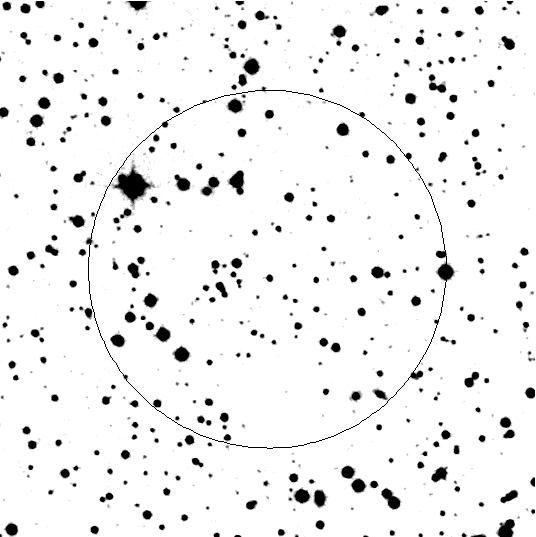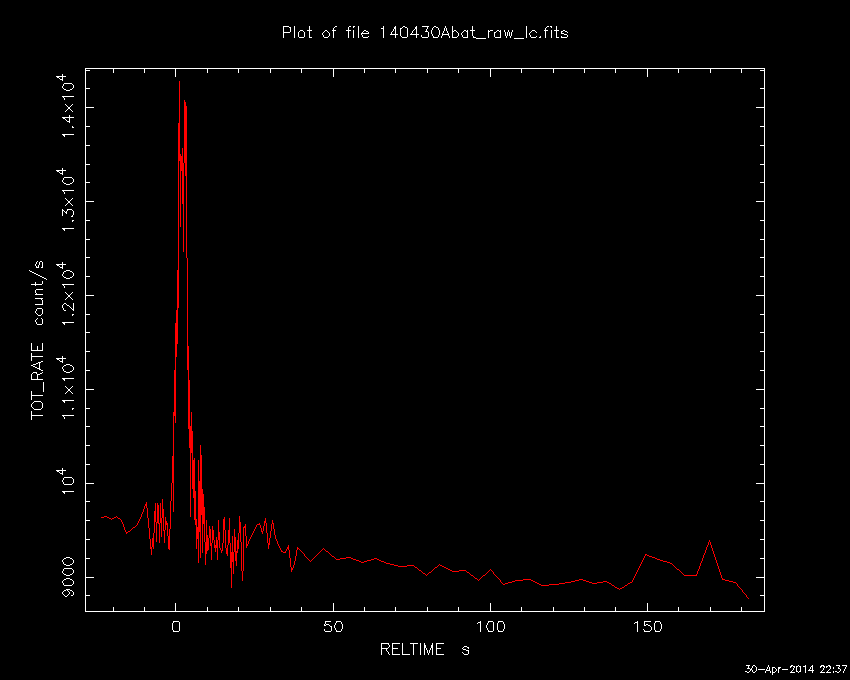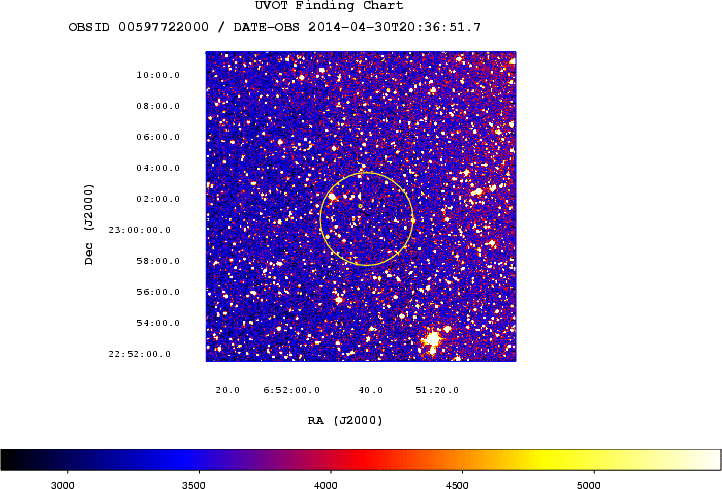(All information courtesy of the instrument teams.)
![]() Previous IAU Circulars
Previous IAU Circulars
TITLE: GCN/SWIFT NOTICE
NOTICE_DATE: Wed 30 Apr 14 20:33:50 UT
NOTICE_TYPE: Swift-BAT GRB Position
TRIGGER_NUM: 597722, Seg_Num: 0
GRB_RA: 102.929d {+06h 51m 43s} (J2000),
103.146d {+06h 52m 35s} (current),
102.173d {+06h 48m 42s} (1950)
GRB_DEC: +23.009d {+23d 00' 34"} (J2000),
+22.991d {+22d 59' 29"} (current),
+23.070d {+23d 04' 12"} (1950)
GRB_ERROR: 3.00 [arcmin radius, statistical only]
GRB_INTEN: 3101 [cnts] Image_Peak=197 [image_cnts]
TRIGGER_DUR: 0.512 [sec]
TRIGGER_INDEX: 121 E_range: 15-50 keV
BKG_INTEN: 36202 [cnts]
BKG_TIME: 74004.04 SOD {20:33:24.04} UT
BKG_DUR: 8 [sec]
GRB_DATE: 16777 TJD; 120 DOY; 14/04/30
GRB_TIME: 74016.52 SOD {20:33:36.52} UT
GRB_PHI: 19.71 [deg]
GRB_THETA: 9.09 [deg]
SOLN_STATUS: 0x3
RATE_SIGNIF: 15.71 [sigma]
IMAGE_SIGNIF: 9.01 [sigma]
MERIT_PARAMS: +1 +0 +0 -1 +1 -1 +0 +0 -47 +0
SUN_POSTN: 38.00d {+02h 32m 00s} +14.94d {+14d 56' 38"}
SUN_DIST: 61.67 [deg] Sun_angle= -4.3 [hr] (East of Sun)
MOON_POSTN: 58.24d {+03h 52m 59s} +17.34d {+17d 20' 20"}
MOON_DIST: 42.37 [deg]
MOON_ILLUM: 3 [%]
GAL_COORDS: 192.26, 10.33 [deg] galactic lon,lat of the burst (or transient)
ECL_COORDS: 101.88, 0.10 [deg] ecliptic lon,lat of the burst (or transient)
COMMENTS: SWIFT-BAT GRB Coordinates.
COMMENTS: This is a rate trigger.
COMMENTS: A point_source was found.
COMMENTS: This does not match any source in the on-board catalog.
COMMENTS: This does not match any source in the ground catalog.
COMMENTS: This is a GRB.
COMMENTS: This trigger occurred at longitude,latitude = 350.72,-9.76 [deg].

TITLE: GCN/SWIFT NOTICE
NOTICE_DATE: Wed 30 Apr 14 20:35:00 UT
NOTICE_TYPE: Swift-XRT Position
TRIGGER_NUM: 597722, Seg_Num: 0
GRB_RA: 102.9359d {+06h 51m 44.61s} (J2000),
103.1525d {+06h 52m 36.59s} (current),
102.1797d {+06h 48m 43.13s} (1950)
GRB_DEC: +23.0227d {+23d 01' 21.7"} (J2000),
+23.0047d {+23d 00' 16.9"} (current),
+23.0832d {+23d 04' 59.6"} (1950)
GRB_ERROR: 4.9 [arcsec radius, statistical plus systematic, 90% containment]
GRB_INTEN: 3.99e-09 [erg/cm2/sec]
GRB_SIGNIF: 11.18 [sigma]
IMG_START_DATE: 16777 TJD; 120 DOY; 14/04/30
IMG_START_TIME: 74067.32 SOD {20:34:27.32} UT, 50.8 [sec] since BAT Trigger Time
TAM[0-3]: 327.67 237.22 261.68 243.51
AMPLIFIER: 2
WAVEFORM: 134
SUN_POSTN: 38.00d {+02h 32m 00s} +14.94d {+14d 56' 39"}
SUN_DIST: 61.67 [deg] Sun_angle= -4.3 [hr] (East of Sun)
MOON_POSTN: 58.26d {+03h 53m 01s} +17.34d {+17d 20' 25"}
MOON_DIST: 42.36 [deg]
MOON_ILLUM: 3 [%]
GAL_COORDS: 192.25, 10.34 [deg] galactic lon,lat of the burst
ECL_COORDS: 101.89, 0.12 [deg] ecliptic lon,lat of the burst
COMMENTS: SWIFT-XRT Coordinates.
COMMENTS: The XRT position is 0.87 arcmin from the BAT position.
COMMENTS: The object found at this position is either a very bright burst or a cosmic ray hit.
COMMENTS: Examine the XRT Image to differentiate (CRs are much more compact); see examples at:
COMMENTS: http://www.swift.psu.edu/xrt/XRT_Postage_Stamp_Image_Photo_Gallery.htm .
TITLE: GCN/SWIFT NOTICE
NOTICE_DATE: Wed 30 Apr 14 20:35:10 UT
NOTICE_TYPE: Swift-XRT Image
TRIGGER_NUM: 597722, Seg_Num: 0
GRB_RA: 102.9359d {+06h 51m 44.6s} (J2000),
103.1525d {+06h 52m 36.5s} (current),
102.1797d {+06h 48m 43.1s} (1950)
GRB_DEC: +23.0227d {+23d 01' 21.7"} (J2000),
+23.0047d {+23d 00' 16.9"} (current),
+23.0832d {+23d 04' 59.6"} (1950)
GRB_ERROR: 4.7 [arcsec, radius, statistical plus systematic]
GRB_INTEN: 125 [cnts]
IMG_START_DATE: 16777 TJD; 120 DOY; 14/04/30
IMG_START_TIME: 74067.32 SOD {20:34:27.32} UT, 50.8 [sec] since BAT Trigger Time
CENTROID_X: 314.67, raw= 315 [pixels]
CENTROID_Y: 268.92, raw= 269 [pixels]
ROLL: 275.08 [deg]
GAIN: 2
MODE: 3, Long Image mode
WAVEFORM: 134
EXPO_TIME: 2.50 [sec]
GRB_POS_XRT_Y: -68.06
GRB_POS_XRT_Z: 22.09
IMAGE_URL: sw00597722000msxps_rw.img
SUN_POSTN: 38.00d {+02h 32m 00s} +14.94d {+14d 56' 39"}
SUN_DIST: 61.67 [deg] Sun_angle= -4.3 [hr] (East of Sun)
MOON_POSTN: 58.26d {+03h 53m 02s} +17.34d {+17d 20' 26"}
MOON_DIST: 42.36 [deg]
MOON_ILLUM: 3 [%]
GAL_COORDS: 192.25, 10.34 [deg] galactic lon,lat of the burst
ECL_COORDS: 101.89, 0.12 [deg] ecliptic lon,lat of the burst
COMMENTS: SWIFT-XRT Image.
COMMENTS: The object found at this position is either a very bright burst or a cosmic ray hit.
COMMENTS: Examine the XRT Image to differentiate (CRs are much more compact); see examples at:
COMMENTS: http://www.swift.psu.edu/xrt/XRT_Postage_Stamp_Image_Photo_Gallery.htm .

TITLE: GCN/SWIFT NOTICE
NOTICE_DATE: Wed 30 Apr 14 20:35:19 UT
NOTICE_TYPE: Swift-XRT Processed Image
TRIGGER_NUM: 597722, Seg_Num: 0
GRB_RA: 102.9359d {+06h 51m 44.6s} (J2000),
103.1525d {+06h 52m 36.5s} (current),
102.1797d {+06h 48m 43.1s} (1950)
GRB_DEC: +23.0227d {+23d 01' 21.7"} (J2000),
+23.0047d {+23d 00' 16.9"} (current),
+23.0832d {+23d 04' 59.6"} (1950)
GRB_ERROR: 4.7 [arcsec, radius, statistical plus systematic]
GRB_INTEN: 125 [cnts]
IMG_START_DATE: 16777 TJD; 120 DOY; 14/04/30
IMG_START_TIME: 74067.32 SOD {20:34:27.32} UT, 50.8 [sec] since BAT Trigger Time
CENTROID_X: 314.67, raw= 315 [pixels]
CENTROID_Y: 268.92, raw= 269 [pixels]
ROLL: 275.08 [deg]
GAIN: 2
MODE: 3, Long Image mode
WAVEFORM: 134
EXPO_TIME: 2.50 [sec]
GRB_POS_XRT_Y: -68.06
GRB_POS_XRT_Z: 22.09
IMAGE_URL: sw00597722000msxps_rw.img
SUN_POSTN: 38.00d {+02h 32m 00s} +14.94d {+14d 56' 39"}
SUN_DIST: 61.67 [deg] Sun_angle= -4.3 [hr] (East of Sun)
MOON_POSTN: 58.26d {+03h 53m 02s} +17.34d {+17d 20' 26"}
MOON_DIST: 42.36 [deg]
MOON_ILLUM: 3 [%]
GAL_COORDS: 192.25, 10.34 [deg] galactic lon,lat of the burst
ECL_COORDS: 101.89, 0.12 [deg] ecliptic lon,lat of the burst
COMMENTS: SWIFT-XRT Processed Image.
COMMENTS: The object found at this position is either a very bright burst or a cosmic ray hit.
COMMENTS: Examine the XRT Image to differentiate (CRs are much more compact); see examples at:
COMMENTS: http://www.swift.psu.edu/xrt/XRT_Postage_Stamp_Image_Photo_Gallery.htm .

TITLE: GCN/SWIFT NOTICE
NOTICE_DATE: Wed 30 Apr 14 20:37:03 UT
NOTICE_TYPE: Swift-BAT GRB Lightcurve
TRIGGER_NUM: 597722, Seg_Num: 0
GRB_RA: 102.929d {+06h 51m 43s} (J2000),
103.146d {+06h 52m 35s} (current),
102.173d {+06h 48m 42s} (1950)
GRB_DEC: +23.009d {+23d 00' 34"} (J2000),
+22.991d {+22d 59' 29"} (current),
+23.070d {+23d 04' 12"} (1950)
GRB_DATE: 16777 TJD; 120 DOY; 14/04/30
GRB_TIME: 74016.52 SOD {20:33:36.52} UT
TRIGGER_INDEX: 121
GRB_PHI: 19.71 [deg]
GRB_THETA: 9.09 [deg]
DELTA_TIME: 32.00 [sec]
TRIGGER_DUR: 0.512 [sec]
SOLN_STATUS: 0x3
RATE_SIGNIF: 15.71 [sigma]
IMAGE_SIGNIF: 9.01 [sigma]
LC_URL: sw00597722000msb.lc
SUN_POSTN: 38.00d {+02h 32m 00s} +14.94d {+14d 56' 40"}
SUN_DIST: 61.67 [deg] Sun_angle= -4.3 [hr] (East of Sun)
MOON_POSTN: 58.27d {+03h 53m 06s} +17.34d {+17d 20' 34"}
MOON_DIST: 42.34 [deg]
MOON_ILLUM: 3 [%]
GAL_COORDS: 192.26, 10.33 [deg] galactic lon,lat of the burst (or transient)
ECL_COORDS: 101.88, 0.10 [deg] ecliptic lon,lat of the burst (or transient)
COMMENTS: SWIFT-BAT GRB Lightcurve.
COMMENTS:
COMMENTS: The next comments were copied from the BAT_POS Notice:
COMMENTS: This is a rate trigger.
COMMENTS: A point_source was found.
COMMENTS: This does not match any source in the on-board catalog.
COMMENTS: This does not match any source in the ground catalog.
COMMENTS: This is a GRB.
COMMENTS: This trigger occurred at longitude,latitude = 350.72,-9.76 [deg].

TITLE: GCN/SWIFT NOTICE
NOTICE_DATE: Wed 30 Apr 14 20:41:19 UT
NOTICE_TYPE: Swift-UVOT Source List
TRIGGER_NUM: 597722, Seg_Num: 0
POINT_RA: 102.927d {+06h 51m 42s} (J2000)
POINT_DEC: +23.003d {+23d 00' 10"} (J2000)
POINT_ROLL: 275.076d
IMG_START_DATE: 16777 TJD; 120 DOY; 14/04/30
IMG_START_TIME: 74199.75 SOD {20:36:39.75} UT, 183.2 [sec] since BAT Trigger Time
FILTER: 10, White
BKG_MEAN: 6.303
N_STARS: 126
X_OFFSET: 488 [pixels]
Y_OFFSET: 607 [pixels]
X_MAX: 1447 [pixels]
Y_MAX: 1566 [pixels]
DET_THRESH: 21
PHOTO_THRESH: 13
SL_URL: sw00597722000msufc0183.fits
SUN_POSTN: 38.00d {+02h 32m 01s} +14.95d {+14d 56' 43"}
SUN_DIST: 61.66 [deg] Sun_angle= -4.3 [hr] (East of Sun)
MOON_POSTN: 58.31d {+03h 53m 15s} +17.35d {+17d 20' 52"}
MOON_DIST: 42.30 [deg]
MOON_ILLUM: 3 [%]
GAL_COORDS: 192.26, 10.32 [deg] galactic lon,lat of the pointing direction
ECL_COORDS: 101.88, 0.10 [deg] ecliptic lon,lat of the pointing direction
COMMENTS: SWIFT-UVOT Source List.
TITLE: GCN/SWIFT NOTICE
NOTICE_DATE: Wed 30 Apr 14 20:41:46 UT
NOTICE_TYPE: Swift-UVOT Processed Source List
TRIGGER_NUM: 597722, Seg_Num: 0
POINT_RA: 102.927d {+06h 51m 42s} (J2000)
POINT_DEC: +23.003d {+23d 00' 10"} (J2000)
POINT_ROLL: 275.076d
IMG_START_DATE: 16777 TJD; 120 DOY; 14/04/30
IMG_START_TIME: 74199.75 SOD {20:36:39.75} UT, 183.2 [sec] since BAT Trigger Time
FILTER: 10, White
BKG_MEAN: 6.303
N_STARS: 126
X_OFFSET: 488 [pixels]
Y_OFFSET: 607 [pixels]
X_MAX: 1447 [pixels]
Y_MAX: 1566 [pixels]
DET_THRESH: 21
PHOTO_THRESH: 13
SL_URL: sw00597722000msufc0183.fits
SUN_POSTN: 38.01d {+02h 32m 01s} +14.95d {+14d 56' 44"}
SUN_DIST: 61.66 [deg] Sun_angle= -4.3 [hr] (East of Sun)
MOON_POSTN: 58.32d {+03h 53m 16s} +17.35d {+17d 20' 54"}
MOON_DIST: 42.29 [deg]
MOON_ILLUM: 3 [%]
GAL_COORDS: 192.26, 10.32 [deg] galactic lon,lat of the pointing direction
ECL_COORDS: 101.88, 0.10 [deg] ecliptic lon,lat of the pointing direction
COMMENTS: SWIFT-UVOT Processed Source List.
COMMENTS: All 4 attachments are included.

TITLE: GCN/SWIFT NOTICE
NOTICE_DATE: Wed 30 Apr 14 20:45:27 UT
NOTICE_TYPE: Swift-UVOT Position
TRIGGER_NUM: 597722, Seg_Num: 0
GRB_RA: 102.9358d {+06h 51m 44.59s} (J2000),
103.1524d {+06h 52m 36.57s} (current),
102.1796d {+06h 48m 43.11s} (1950)
GRB_DEC: +23.0236d {+23d 01' 24.9"} (J2000),
+23.0056d {+23d 00' 20.1"} (current),
+23.0841d {+23d 05' 02.8"} (1950)
GRB_ERROR: 0.6 [arcsec radius, statistical only]
GRB_MAG: 18.15 +/- 0.14 [mag]
FILTER: 10, White
IMG_START_DATE: 16777 TJD; 120 DOY; 14/04/30
IMG_START_TIME: 74198.00 SOD {20:36:38.00} UT, 181.5 [sec] since BAT Trigger Time
SUN_POSTN: 38.01d {+02h 32m 02s} +14.95d {+14d 56' 47"}
SUN_DIST: 61.67 [deg] Sun_angle= -4.3 [hr] (East of Sun)
MOON_POSTN: 58.35d {+03h 53m 25s} +17.35d {+17d 21' 10"}
MOON_DIST: 42.27 [deg]
MOON_ILLUM: 3 [%]
GAL_COORDS: 192.25, 10.34 [deg] galactic lon,lat of the burst (or transient)
ECL_COORDS: 101.89, 0.12 [deg] ecliptic lon,lat of the burst (or transient)
COMMENTS: SWIFT UVOT Position Notice.
COMMENTS: This Notice was ground-generated -- not flight-generated.
COMMENTS: The UVOT position is 3.2 arcsec from the XRT position.
COMMENTS: Result based on Genie data.
COMMENTS: Notice generated automatically.
RA(J2000) = 06h 51m 43s Dec(J2000) = +23d 00' 34"with an uncertainty of 3 arcmin (radius, 90% containment, including systematic uncertainty). The BAT light curve shows a single peak with a duration of about 10 sec. The peak count rate was ~4500 counts/sec (15-350 keV), at ~1 sec after the trigger.
RA(J2000) = +06h 51m 44.62s Dec(J2000) = +23d 01' 21.7"with an uncertainty of 4.9 arcseconds (radius, 90% containment). This location is 54 arcseconds from the BAT onboard position, within the BAT error circle. No event data are yet available to determine the column density using X-ray spectroscopy.
RA = 06:51:44.61 Dec = +23:01:25.1with an uncertainty of 0.3". Assuming R = 15.13 for the USNO star at RA = 06:51:41.3, Dec = +23:01:44.0, we measure for the optical afterglow a magnitude R = 18.78 +- 0.02 (statistical error only).
RA (J2000): 06h 51m 44.58s Dec (J2000): +23d 01' 25.5"with an uncertainty of 1.9 arcsec (radius, 90% confidence).
Galactic foreground: 2.1 x 10^21 cm^-2 Intrinsic column: 5.3 (+6.5, -5.3) x 10^21 cm^-2 at z=1.6 Photon index: 2.21 (+0.20, -0.19)If the light curve continues to decay with a power-law decay index of 0.68, the count rate at T+24 hours will be 0.018 count s^-1, corresponding to an observed (unabsorbed) 0.3-10 keV flux of 6.0 x 10^-13 (9.6 x 10^-13) erg cm^-2 s^-1.
Filter T_start(s) T_stop(s) Exp(s) Mag white_FC 183 333 147 18.17 =B1 0.09 white 4020 4220 197 19.61 =B1 0.17 v 417 4630 216 >18.6 b 3815 4015 197 19.77 =B1 0.34 u 10431 10933 490 19.46 =B1 0.19 uvw1 6178 10424 966 20.40 =B1 0.31 uvm2 442 4835 216 >19.9 uvw2 393 4425 216 >19.4The magnitudes in the table are not corrected for the Galactic extinction due to the reddening of E(B-V) =3D 0.14 in the direction of the burst (Schlegel et al. 1998).
RA(J2000) = 06h 51m 46.0s Dec(J2000) = +23d 01' 58.2"with an uncertainty of 1.0 arcmin, (radius, sys+stat, 90% containment). The partial coding was 100%.
T0+[sec] MID-UT T-EXP[sec] g' Rc Ic --------------------------------------------------------------------------------------- 54229 11:37:25 3540 >19.2 >19.5 >19.2 --------------------------------------------------------------------------------------- T0+ : Elapsed time after the burst T-EXP: Total Exposure timeWe used GSC2.3 catalog for flux calibration.